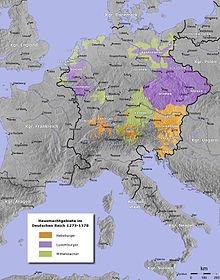|
House of Luxembourg
The House of Luxembourg (Luxembourgish: D'Lëtzebuerger Haus; French: Maison de Luxembourg; German: Haus Luxemburg) or Luxembourg dynasty was a royal family of the Holy Roman Empire in the Late Middle Ages, whose members between 1308 and 1437 ruled as kings of Germany and Holy Roman emperors as well as kings of Bohemia, Hungary and Croatia. Their rule was twice interrupted by the rival House of Wittelsbach. The family takes its name from its ancestral county of Luxembourg which they continued to hold. HistoryAs shown below, this royal Luxembourg dynasty were not male-line descendants of the original counts of Luxembourg. They descended instead from the House of Limburg-Arlon, who had been dukes of Lower Lorraine in the 11th century. In 1247 Henry, younger son of Duke Waleran III of Limburg inherited the County of Luxembourg, becoming Count Henry V of Luxembourg, upon the death of his mother Countess Ermesinde. Her father, Count Henry "the blind", was count of Namur through his father, and count of Luxembourg through his mother, who was also named Ermesinde. This elder Ermesinde was a member of the original House of Luxembourg, which was a branch of the House of Ardenne, and had ruled Luxembourg since the late 10th century. There were two other houses descended from the women of the counts of Luxembourg as shown in the family tree in the House of Ardenne–Luxembourg: the Counts of Loon, the Counts of Grandpré, along with the Dukes of Limburg. All three families had a place in relation to the succession of the House of Ardennes. Indeed, the Count of Grandpré was the next heir of Conrad II of Luxembourg, who was the last representative of the Ardennes dynasty. But, Emperor Frederick II preferred that Luxembourg was held by a lord Germanic rather than French and attributed the county to Henry of Limburg-Arlon (see below), son of Conrad's aunt Ermesinde and Count Godfrey I of Namur. The Counts of Loon are also in position to claim the inheritance Luxembourg, albeit weaker position.  Habsburg Luxembourg Wittelsbach Henry V's grandson Henry VII, Count of Luxembourg upon the death of his father Henry VI at the 1288 Battle of Worringen, was elected Rex Romanorum in 1308. The election was necessary after the Habsburg king Albert I of Germany had been murdered, and Henry, backed and orchestrated by his brother Archbishop-Elector Baldwin of Trier, prevailed against Charles, Count of Valois. Henry arranged the marriage of his son John with the Přemyslid heiress Elisabeth of Bohemia in 1310, through whom the House of Luxembourg acquired the Kingdom of Bohemia, enabling that family to compete more effectively for power with the Habsburg and Wittelsbach dynasties. One year after being crowned Holy Roman Emperor at Rome, Henry VII, still on campaign in Italy, died in 1313. The prince-electors, perturbed by the rise of the Luxembourgs, disregarded the claims raised by Henry's heir King John, and the rule over the Empire was assumed by the Wittelsbach duke Louis of Bavaria. John instead concentrated on securing his rule in Bohemia and gradually vassalized the Piast dukes of adjacent Silesia from 1327 until 1335. His son Charles IV acceded to the Imperial throne in 1346. His Golden Bull of 1356 served as a constitution of the Empire for centuries. Charles not only acquired the duchies of Brabant and Limburg in the west, but also the former March of Lusatia and even the Margraviate of Brandenburg in 1373 under the Kingdom of Bohemia. The family's decline began under Charles' son King Wenceslaus, deposed by the prince-electors in 1400 who chose the Wittelsbach Elector Palatine Rupert. In 1410 rule was assumed by Wenceslaus' brother Sigismund, who once again stabilized the rule of the Luxembourgs and even contributed to end the Western Schism in 1417; however, with his death in 1437, the senior branch of the dynasty became extinct. He was succeeded by his son-in-law, the Habsburg archduke Albert V of Austria. The Habsburgs finally prevailed as Luxembourg heirs, ruling the Empire until the extinction of their senior branch upon the death of Maria Theresa in 1780. Notable members
GenealogyHouse of Limburg–ArlonHaving succeeded to the county of Luxemburg, the younger branch of the House of Limburg-Arlon is the family that succeeded in getting one of its scions elected Holy Roman Emperor. From there descended the Kings of Bohemia, several other Emperors and a King of Hungary as shown below.
Earlier Luxembourg countsThe royal House of Luxemburg are named after their ancestors in the Luxembourg branch of the earlier House of Ardenne (or Ardennes, French Maison d'Ardenne). This was an important noble family from Lotharingia, known from at least the tenth century. They had several important branches, descended from several brothers:[2]
See alsoReferencesWikimedia Commons has media related to House of Luxembourg.
|
|||||||||||||||||||||||||||||||||||||||||||||||||||||||||||||||||||||||||||||||||||||||||||||||||||||||||||||||||||||||||||||||||||||||||||||||||||||||||||||||||||||||||||||||||||||||||||||||||||||||||||||||||||||||||||||||||||||||||||||||||||||||||||||||||||||||||||||||||||||||||||||||||||||||||||||||||||||||||||||||||||||||||||||||||||||||||||||||||||||||||||||||||||||||||||||||||||||||||||||||||||||||||||||||||||||||||||||||||||||||||||||||||||||||||||||||||||||||||||||||||||||||||||||||||||||||||||||||||||||||||||||||||||||||||||||||||||||||||||||||||||||||||||||||||||||||||||||||||||||||||||||||||||||||||||||||||||||||||||||||||||||||||||||||||||||||||||||||||||||||||||||||||||||||||||||||||||||||||||||||||||||||||||||||||||||||||||||||||||||||||||||||||||||||||||||||||||||||||||||||||||||||||||||||||||||||||||||||||||||||||||||||||||||||||||||||||||||||||||||||||||||||||||||||||||||||||||||||||||||||||||||||||||||||||||||||||||||||||||||||||||||||||||||||||||||||||||||||||||||||




















